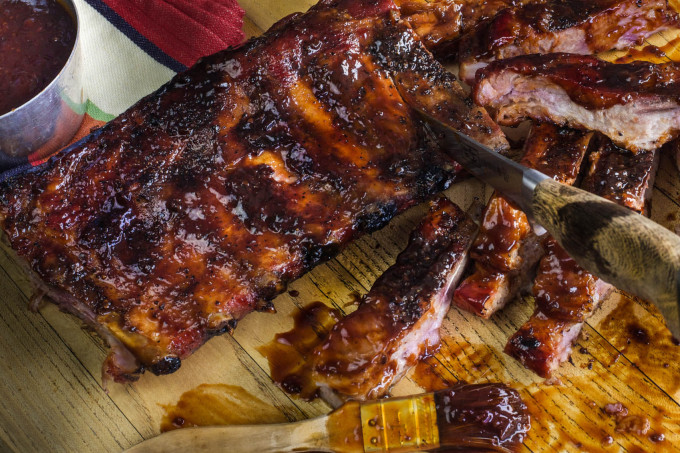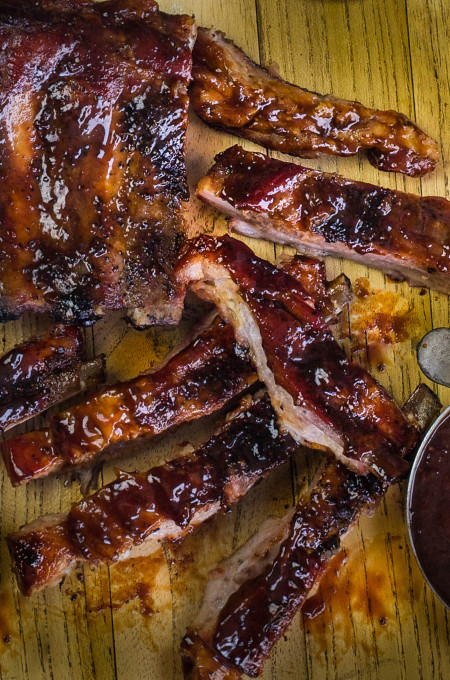“Low and slow, son,” that’s what my daddy always told me was the key to cooking ribs. He’d fire up the pit on a Saturday morning and by the time the afternoon sun was setting, we’d be in pig heaven. Growing up in small town Louisiana, pork ribs–especially spareribs (my father’s favorite)–was the only barbecue I knew. I love a good Texas brisket and Carolina pulled pork with a tangy mustard sauce hits me in the sweet spot, but for me, a rack of hickory-smoked spareribs is real, honest-to-goodness barbecue. And my sweet recipe for Sugarcane-Glazed Spareribs will have you falling in love with them, too.

For my Sugarcane-Glazed Spareribs, I use St. Louis cut spareribs smoked to perfection and glazed at just the right time. (All photos credit: George Graham)
Now, I will admit that I got off track sometime back during the baby back craze of the 1990s. Seems you couldn’t go anywhere and not see those perfectly trimmed rib racks slathered with cloyingly sweet sauce featured on a restaurant menu. And in the meat case of my local supermarket, there they were: dainty little racks of baby backs cryo-vac sealed and ready for the grill. I joined in.
Don’t get me wrong, when done right, tender baby back ribs (from the loin back) are quite tasty. But, true rib connoisseurs (and old-timers like my father) understand that spareribs – the choice for my recipe for Sugarcane-Glazed Spareribs – are where the flavors at. You see, spareribs come from the belly of the beast; where bacon comes from. So, what makes bacon so delicious–fat–is also what brings enormous flavor to spareribs. They are larger than baby backs and spareribs require a longer cooking time. But done right, the flavor and texture of well-cooked barbecue spareribs are the best.
Like I use for my Sugarcane-Glazed Spareribs recipe, buy the St. Louis-style spareribs. These are cut and trimmed to a more manageable rectangular shape for even cooking. Most any butcher will know exactly how this is done, and make sure to ask him to remove the leathery membrane from the bony backside of the ribs. And if you buy your St. Louis-style ribs already packaged, you can remove the membrane easily with a sharp paring knife. Oiled up and seasoned with a Cajun dry rub, your spareribs will be ready to cook in no time.
In the past, I’ve always been a purist when it comes to barbecue of any kind, choosing to smoke meats over a real charcoal fire. But, in the past few years I’ve joined the legions of gas grill gurus who like the convenience and speed of cooking barbecue without the hassle of live fire and the ash-laden cleanup that follows. Call me lazy if you like, but I’ve found that with the right combination of advance preparation and cooking methods, you would be challenged to tell the difference.
My Sugarcane-Glazed Spareribs technique is based on indirect cooking on a gas grill with at least two individually controlled heat sources. One side of the grill (with the wood chips) is hot, and the other side (with the meat) is not. I place hickory chunks and chips into a deep rectangular, disposable aluminum pan, cover with foil and punch a few holes for the smoke to escape. Filled halfway with wood and placed directly over the heat source, this smoker rig will give you about an hour of smoke. And you will need a working oven thermometer to control the temperature to a low and slow 275ºF. Other than that, the setup is a breeze and the clean up is as easy as tossing the disposable pan.
So, I’m happy to say I’ve changed back to spareribs, and I’m here to stay. This Labor Day fire up the pit for a backyard barbecue celebration, and if you follow this Cajun recipe for my Sugarcane-Glazed Spareribs, just like me, you’ll change to spare as well.
- 1 cup ketchup
- ½ cup sugarcane molasses, such as Steen’s
- ¼ cup sugarcane vinegar, such as Steen’s or apple cider vinegar
- 1 tablespoon Creole mustard, such as Zatarain’s
- 1 tablespoon kosher salt
- 1 tablespoon black pepper
- 1 tablespoon onion powder
- 1 tablespoon garlic powder
- 1 tablespoon chili powder
- ½ teaspoon liquid smoke
- ¼ cup water
- ½ cup kosher salt
- ¼ cup smoked paprika
- ¼ cup chili powder
- 2 tablespoons white pepper
- 2 tablespoons black pepper
- 2 tablespoons cayenne pepper
- 4 tablespoons granulated garlic
- 4 tablespoons onion powder
- 2 tablespoons cumin
- 2 racks St Louis style pork spareribs (3 to 4 pounds each), trimmed with membrane removed
- 4 tablespoons vegetable oil
- 4 cups water
- 4 cups apple juice
- In a saucepan over medium heat, add all the ingredients. Bring to a boil and reduce the heat to a simmer. Cook until the sauce thickens to coat the back of a spoon, about 20 minutes. Keep warm until ready to use. Any excess should be stored in a jar with tight-fitting lid and refrigerated for up to a month.
- In a mixing bowl, add all ingredients and combine. Pour into a clean, dry Mason jar and seal. Stored in a dry pantry, it should keep for six months or longer.
- Rinse the spareribs and pat dry. Move them to a tray and inspect that the tough membrane has been removed. Rub the ribs with oil and coat evenly with the dry rub mix. Place on the tray, cover with foil and let rest at room temperature for 1 hour.
- Preheat your gas grill by turning on the burners on one side of the grill only. Clean the grill on the other side where the ribs will cook. Place an oven thermometer on the grill and cover.
- In a disposable 6-inch deep aluminum foil pan, fill halfway with a combination of hickory wood chips and chunks that have soaked in water for at least 1 hour. Seal the pan tightly with aluminum foil and poke a few holes in the foil cover. In another aluminum foil container, pour the water and apple juice to the halfway point.
- On the cold side of the grill, add the ribs meat side down. On the hot side of the grill, remove the grates and place the aluminum foil pan containing the hickory wood directly over the burners. Reduce the burners to low and replace the grates. Position the pan of water/apple juice on the grates directly over the burners and wood. Check the thermometer and adjust the gas burners to bring to and maintain a temperature of 275ºF. Close the grill and let cook watching to see that smoke is ventilating from the closed grill as it cooks.
- After 1 hour, the smoke should no longer be ventilating and it is time to check the first cooking. Open the cover, check the inside temperature and replenish the hickory wood as well as adding more liquid, if needed. Cover the grill and cook for a second hour of smoking.
- After 2 hours, the smoke will have done its job. Open the cover and remove the water pan as well as the hickory wood pan. Turn the ribs over to the bone side and continue cooking for another hour.
- At this point (3 hours of cooking), uncover the grill and wrap the ribs in aluminum foil. Again, check to see that the temperature is maintained at 275ºF. Cover the grill and continue cooking for 1 hour.
- Uncover the grill and unwrap the ribs. With a knife, remove one of the ribs to check for doneness. Well-cooked spareribs should not “fall-off-the-bone”, but rather should tug away from the bone and still have enough texture to bite into. There should also be a crimson colored smoke ring around the meat. If the meat is not sufficiently cooked to a tenderness, then rewrap in foil and cook longer checking for doneness each half hour.
- Once the ribs are tender, mop on the sugarcane sauce with a generous coating on both sides. Place the ribs (in the aluminum foil uncovered) back on the grill, close the grill and let cook just until the sauce warms through and the glaze sets, about 10 to 15 minutes. (Note: control your heat and be sure not to let the sauce burn.)
- Remove the ribs to a tray, cover with foil and let rest for 10 minutes. For serving, slice the ribs along each bone and pile onto a platter with more of the sugarcane sauce on the side. In South Louisiana, we serve barbecue with hot French bread, cold potato salad, and baked beans. Oh, and lots of ice-cold beer.
For the rub, you will see that this rib rub contains a healthy dose of salt for dry brining which helps retain moisture and form bark (crust) on the ribs. The other ingredients are pungent spices for pronounced flavor, not subtle herbs that tend to get lost in the smoking. This rub does not contain any sugar in order to prevent burning in the early stages of cooking. And remember, the ribs will be glazed with a sweet mopping sauce at the end.
For the glaze, this is a sweet, tangy sauce that should be added at the final stage of cooking. Watch carefully -- a properly sauced rack of ribs should have a warm sticky glaze but never burnt and blackened.

Sweet and sticky, these sugarcane-glazed spareribs have the perfect balance of smoke and spice.
YOUR SEAT AT THE TABLE: If you like this Cajun cooking story and Cajun recipe then accept my personal invitation to subscribe by entering your email at the bottom or top right of this page. It’s quick and painless. You will receive an email alert and be the first to see when new Cajun cooking stories and Cajun recipes are added. Thanks, George.
Hi George,
I am wondering if the ribs stay on the cold side of the grill for the entire cooking process
Hey Cheryl-
Good question. Let me clarify: when cooking on a grill over indirect heat, the word “cold” means the side opposite the flame (hot) side of the grill. There is still plenty of heat reaching the ribs to cook them. The key to ribs and most any “low and slow” barbecue is to keep the flames from flaring as the fat renders, which inevitably results in burnt meat. So keep the spareribs away from the flame and watch your thermometer to maintain an even temperature. Best, George